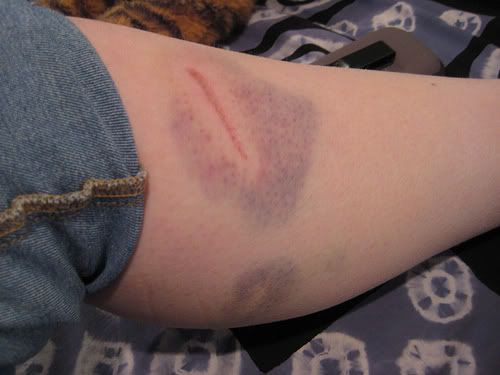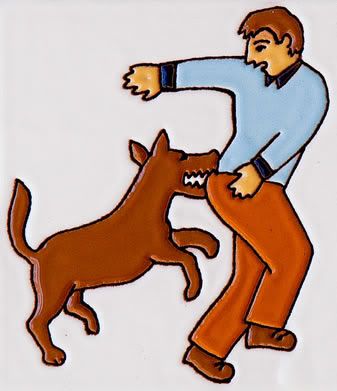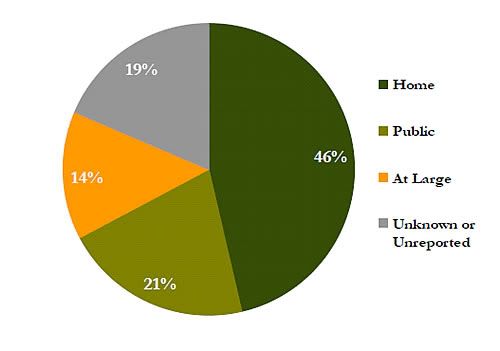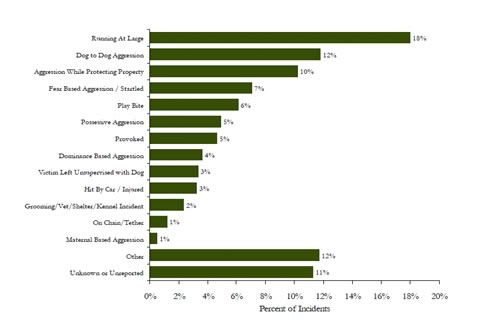
Above: Dog Bite Photo by Sporko
It is Dog Bite Prevention Week and most people are talking about how to prevent bites but usually do not talk about what action steps might be taken to keep yourself safe or to break up a dog fight safely.
Andrew, a regular reader and author of 2 Feet 4 Paws, asked me about the actions people might take if they want to stop an attack. So Andrew–at long last here is your post…
Now I have to say that each situation is unique and these are only general guidelines.
This means that you are ultimately responsible for doing further research to educate yourself and for taking action to protect yourself or your dog–no one else can do it for you.
Many dog bites occur when a human intervenes during a dog fight so when it comes to dog-to-dog aggression owners should
- restrain and socialize their dogs,
- educate themselves about normal canine play,
- learn the warning signals canines exhibit,
- and learn how to safely intervene if a fight occurs.
Okay, so assuming that you have taken these actions let’s move on to some more specifics.
Take action before, during, or after a dog attack?
Ideally the time to take action is before an incident escalates into something serious.
Prevention is the best strategy which is what Dog Bite Prevention Week is about.
However, most pet owners do not recognize the early signals dogs exhibit before attacking or biting–and I recently read a blog post by an agility dog training student whose dog was attacked by her trainer’s dog!
Often the owner’s, trainer’s or handler’s relationship with the animal can be used to prevent an incident. Having said that I believe that most incidents occur due to human error.
In most situations distraction can work before an incident escalates– and can usually be used to prevent an incident or redirect the energy elsewhere.
Once an altercation begins there are actions people can take during the incident but there is a great risk of dog bites. Safety of the people, the public, and the animal are all concerns that should be taken seriously.
The wrong interference can also escalate an event. Depending on the nature of the animal(s), the location, and the people on hand will determine what actions you can take and may make response difficult.
Resources nearby or on-hand can also be critical pieces for mitigating or intervening in a dog attack so you should make it a habit to scope out your surroundings in the event you face a threat.
Planning
Knowledge of your dog and his or her behavior is critical. If you know that your dog reacts aggressively in certain situations, or toward different animals, you should be prepared to avoid those situations and animals.
You should always be alert to other animals in the area that might be threats to you or your pet.
A good rule of thumb is to project your focus forward between 50-100 feet.
This doesn’t mean you don’t pay attention to your immediate surroundings but that you also scan ahead so you can anticipate and take steps to prepare for the worst if you need to.
Preparedness
Knowledge of what type of actions or devices can be used to assist in the event an emergency is only part of the equation–you also have to know how to use the devices correctly!
The key is to know that you can use a barrier, jacket, or a deterrent in a sticky situation because it helps calm you and gives you the confidence to take action instead of reacting blindly.
Distraction
This is something that is done to distract an animal away from an area, event, or item. Generally verbal or audio distraction is used but sometimes visual or physical distraction can work. The use of distraction comes just BEFORE the animal is reacting.
- Audio Noise distraction can often startle an animal away. Loud marine or sport horns, clashing metal trash can lids, banging on metal containers, and other noise makers can be quite effective.
- Voice I’ve had great luck telling dogs to “git home” and pointing the opposite way. Most dogs become startled if you do this. The key is to make sure that this is done while they are still a good distance away.
Caution: If a dog is aggressive toward you in most cases it is best to avoid a direct eye stare. This challenge can provoke some dogs into attacking.
Physical Barrier
Trash can lids can be used as a shield but anything that you can place between yourself and another animal can help stop an attack–be creative.
Psychological Control/Spacial Distance
Using the flight distance of some animals can help to move them away.
Policemen usually exhibit the right body posture and verbal commands to elicit this response–pet owners could do the same to gain control of their own animal–again this strategy is used normally prior to an incident.
Physical Action
Restraining an animal or to using some sort of other method, such as the stream of water from a fire hose or a bucket of water are a couple of examples. It is always best to avoid inserting yourself (or your limbs) between animals in an altercation.
Getting an animal into another location such as a public restroom and closing the exterior door, getting into your vehicle, relocating so there is a fence between the dogs or using something else as a barrier all work well.
“Wheelbarrow”
If two dogs are in a fight I’ve had success with throwing a jacket over the head of the dogs (or the main aggressor) and grabbing the back legs and lifting while moving back. They key is to keep moving to avoid having the dog lash back.
Chemical Interference
Pepper spray, mace, or ammonia and water are some of the emergency remedies that some people have on them when working animals. I carry mace and a product called Direct Stop in my training bag.
Other
It is important to remember that with most species, the reaction to aggression is more escalated aggression.
However, other than sprinting and pole vaulting, some things to remember are that you can also hit the sensitive areas on an animal.
Where are the vital areas? (eyes, nose, genitals, etc.,) Can you knock the air out of them?
Along with a loud yell, I’ve used the top of my foot to wind an aggressor by hitting it in the gut to get it off another dog that he had on the ground. I don’t recommend it but sometimes you have to do what it takes to intervene.
Audio and visual distraction can be done very effectively with CO2 fire extinguishers. I also use the Barker Breaker as an interrupter.
As a last resort Hot Shots, Cattle Prods, or Tazers will also work. Batteries must be charged for them to work so they should be monitored and tested periodically.
Resources
In the event of a dog bite, cell phones allow you to snap photos of aggressive animals, document locations, bites, owners, and to program emergency contact numbers in your phone.
What numbers should be programmed into your phone?
Add the veterinary emergency clinic, your regular veterinary office number, animal services, the sheriff or police station numbers, the local hospital, and your emergency contact numbers.
Now it is your turn do you have any tips and hints on how to effective stop a dog attack or how to prevent dog bites? If so, leave your comment below.
 It is Dog Bite Prevention Week and I wanted to alert you to an interesting report that was done in Colorado.
It is Dog Bite Prevention Week and I wanted to alert you to an interesting report that was done in Colorado. Above: Dog Bites in Colorado Chart of Where Dog Bites Occur
Above: Dog Bites in Colorado Chart of Where Dog Bites Occur Above: Situations Where Dog Bite Incidents Occur from Colorado Study
Above: Situations Where Dog Bite Incidents Occur from Colorado Study
